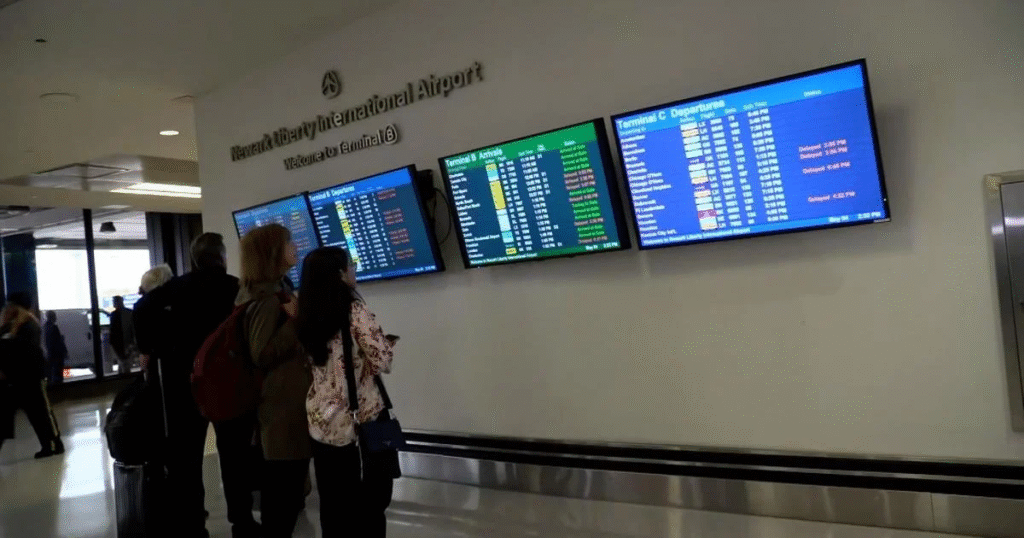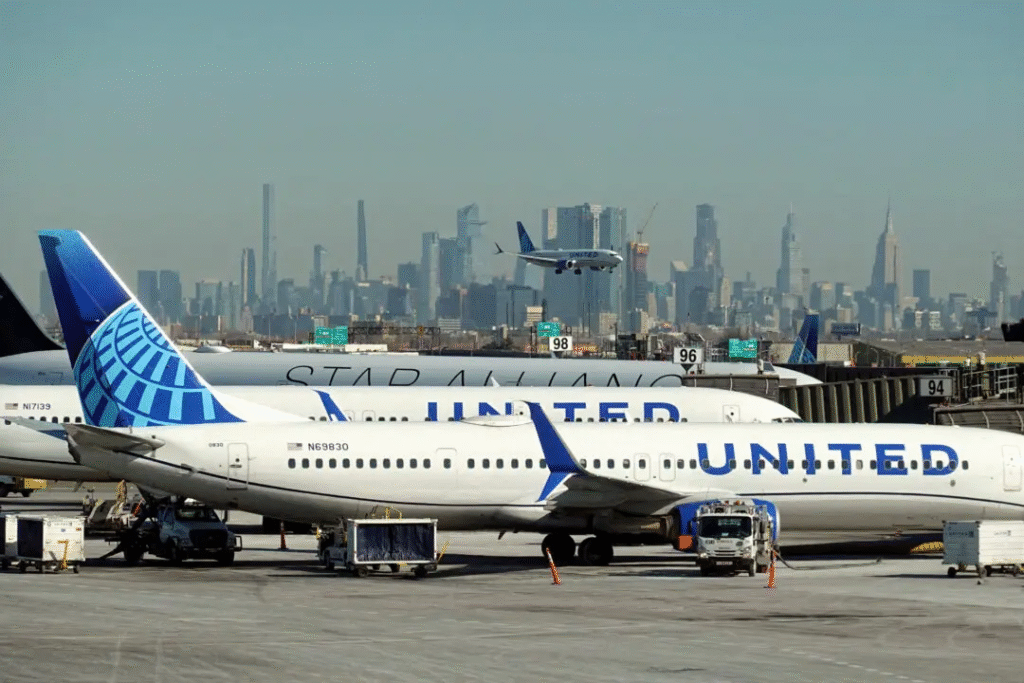Widespread Air Traffic Controllers Take Trauma Leave After Communication Breakdown at Newark Airport Causes Prolonged Flight Delays
Widespread A significant disruption in air traffic control communications at Newark Liberty International Airport has led to hundreds of flight delays and cancellations, continuing into a second week. The breakdown in communication was traced back to a critical failure involving the radar and radio systems used by air traffic controllers, prompting several employees to take extended leave to recover from the psychological toll of the incident.
Widespread According to a statement from the National Air Traffic Controllers Association (NATCA), the controllers affected are based at the Philadelphia Terminal Radar Approach Control (TRACON) facility, which manages the flight paths of planes approaching and departing Newark, one of the nation’s busiest airports.
Widespread “For a period of time, they couldn’t see, hear, or speak to any of the planes under their jurisdiction,” NATCA said. “This unprecedented failure left them completely cut off, creating a deeply stressful and potentially dangerous situation.”
Widespread Sources familiar with the matter told CNN that the failure stemmed from a total collapse of the link between Federal Aviation Administration (FAA) radar systems and the communication frequencies controllers rely on to direct air traffic. The outage not only jeopardized the safe coordination of flights but also left air traffic personnel without the tools they needed to ensure aircraft separation — a vital function in aviation safety.
Widespread At least five FAA employees have since taken 45 days of special trauma-related leave, a form of government-authorized absence reserved for workers recovering from extreme stress or psychologically harmful events. These employees are expected to use the time to recuperate from the intense pressure they faced during the system failure.
Widespread The incident highlights broader concerns about the condition of the FAA’s technological infrastructure, which officials acknowledge is outdated and increasingly vulnerable to breakdowns.
Widespread “The FAA’s aging air traffic control system is placing an enormous burden on our personnel,” the agency said in a public statement.
Widespread The FAA is now working on several fronts to address the root of the problem. Efforts include overhauling the existing automation system to make it more robust in the face of technical issues, as well as reinforcing the telecommunications hardware supporting air traffic operations across the New York metropolitan area, where traffic density is among the highest in the country.
Widespread The fallout from the communication failure has now extended into an eighth consecutive day, an unprecedented disruption for a major airport like Newark. Thousands of travelers have experienced flight delays, cancellations, and missed connections as air traffic staffing remains below normal levels.
Widespread Passengers have expressed frustration over the lack of timely updates and the ripple effect of rescheduled flights that continue to throw airline operations into disarray.
“I had three flights canceled in two days,” said one traveler heading to Chicago. “They finally got me on a plane, but the delays have been insane.”
The aviation industry is feeling the strain as well. Airline executives have voiced concerns about the pace of FAA modernization and the shortage of trained controllers available to step in during such crises. Air traffic control is a highly specialized profession, requiring years of training and rigorous certification. As such, replacing even a small number of controllers isn’t something that can be done overnight.
“While we cannot rapidly fill these vacancies due to the complexity and specialization involved in training air traffic personnel, we are actively continuing training programs,” the FAA said. “These trainees will eventually help support high-demand airspaces like the one around Newark.”

The Philadelphia TRACON facility, where the affected controllers are based, plays a pivotal role in managing aircraft movements not only at Newark but also for other airports in the Northeast. The sudden loss of control over Newark airspace during the outage forced air traffic managers to reroute or ground flights to prevent collisions and reduce risks, creating a backlog that has taken days to unwind.
Industry analysts say the incident is another warning sign that the national air traffic control system needs significant upgrades. Modernizing these systems has been a long-standing challenge due to budget constraints, bureaucratic delays, and the sheer complexity of replacing decades-old technology with newer digital infrastructure — all while keeping the system running 24/7.
“The stress that these controllers experienced was not only understandable but predictable,” said an aviation safety consultant. “When you’re dealing with outdated equipment in high-pressure environments, the risks multiply — not just for passengers, but for the professionals keeping the skies safe.”
The FAA, while not offering a detailed timeline for repairs or full restoration of operations at Newark, has committed to accelerating its modernization plans. In the meantime, staffing shortages and operational bottlenecks are expected to persist until the affected controllers return from leave and full communications capabilities are restored.
As investigations continue into the exact technical causes of the outage, both the FAA and NATCA are calling for greater investment in aviation infrastructure, warning that without serious upgrades, similar events could occur again.
“This event underscores the urgent need for sustained federal funding and attention to air traffic system modernization,” NATCA stated. “We cannot ask our workforce to operate under these conditions and expect consistent safety and efficiency.”
Travelers are advised to monitor airline updates closely and plan for possible delays as Newark operations gradually return to normal.
Radar Failure at Newark Liberty Leaves Controllers in the Dark, Causing Days of Delays and Growing Safety Concerns
On Monday, the chaos at Newark Liberty International Airport intensified, as 160 flights were canceled and another 375 delayed, according to data from flight tracking website FlightAware.
The Federal Aviation Administration (FAA) has warned that travelers should brace for more disruptions as technical issues and staffing shortages persist.
Sudden Silence in the Skies
Air traffic controllers working out of the Philadelphia Terminal Radar Approach Control (TRACON), which manages the busy Newark airspace, were thrust into a crisis last week when their systems abruptly failed. According to control tower audio obtained by CNN and recorded on LiveATC.net, controllers lost the ability to track aircraft on radar and could no longer communicate via radio with pilots. For several minutes, they were effectively blind and mute — an incredibly dangerous scenario in one of the busiest air corridors in the U.S.
“Approach, are you there?” a pilot asked repeatedly, receiving no answer.
During the breakdown, around 15 to 20 planes were under the guidance of controllers at the time radar and communications failed, according to flight tracking site Flightradar24. The pilot attempted five separate times to make contact before finally receiving a reply:
“United 1951, how do you hear me?” the controller asked.
“Got you loud and clear,” the pilot responded, audibly relieved.

The controller instructed, “We lost our radar, so just stay on the arrival and maintain 6,000 feet.” Although the aircraft later reappeared on radar, its position was misaligned, prompting further concern.
Dangerous Confusion in Crowded Airspace
For smaller aircraft trying to enter the busy airspace near Newark, the failure created more confusion and frustration. One pilot asked if he had clearance to enter Class B airspace — heavily restricted airspace around major airports.
The recordings reveal the immense pressure on the controllers, forced to make judgment calls in real time with inadequate tools. The stress and uncertainty of the situation have had serious emotional consequences for those involved.
Controllers Take Leave Under Trauma Policy
Following the incident, at least five FAA employees took trauma leave under the Federal Employees’ Compensation Act, which allows time off for federal workers who suffer physical or psychological harm on the job.
United Airlines CEO Scott Kirby added fuel to the controversy last Friday by stating that over 20% of controllers at Newark “walked off the job.” He emphasized that United.
“These professionals didn’t abandon their post — they followed legal procedures after experiencing an extraordinary and dangerous failure of their equipment,” a NATCA spokesperson said. “To frame it as a walkout is misleading and disrespectful to their professionalism and mental well-being.”
A source familiar with the incident echoed that view, explaining, “They didn’t just leave. They were traumatized. Their radar and comms failed, and they were responsible for dozens of lives in the sky. This is exactly the kind of situation the trauma policy is designed to address.”
FAA Scrambles to Contain Fallout
The agency is now prioritizing upgrades to its automated systems and telecommunications infrastructure, particularly in the high-traffic New York and New Jersey region.
However, the agency admits that replacing trained air traffic controllers, especially those managing complex airspace like Newark’s, is not a quick fix. Training new controllers can take several years, and the pool of qualified candidates remains small due to the demanding nature of the job.
“We are actively training new personnel, but due to the technical expertise required, those replacements will not be ready immediately,” the FAA stated.
Meanwhile, air traffic at Newark remains unstable. Controllers from nearby facilities have been assisting, but without full radar coverage and a complete staff, delays are unavoidable.
Industry Experts Sound Alarm
“While we generally have one of the safest air travel systems in the world, any situation where you’re pushing controllers to their limits — both technically and emotionally — introduces unacceptable risk,” Goelz told CNN. “Passengers should be concerned, and officials should be taking immediate action to restore full capabilities.”
A Prolonged Recovery
As the crisis drags into its second week, travelers at Newark are dealing with crowded terminals, long wait times, and frequently changing departure boards. Airlines have struggled to rebook passengers or redirect flights to nearby airports, as the staffing shortage limits options.
Many travelers are unaware of the complex technical issues behind the delays, but frustration is mounting. For those in the aviation field, however, the incident is a clear wake-up call.
“This is a textbook example of how fragile our system is,” said one aviation analyst. “And it’s only going to get worse unless we modernize and prioritize the people who keep our skies safe.”
“I don’t think I’d feel comfortable flying out of Newark in the next week or so — maybe even for the next 10 days,” one aviation expert said. “When people are working under intense, unrelenting stress like this, it’s unrealistic to expect them to keep performing at their best.
U.S. Secretary of Transportation Sean Duffy echoed similar concerns during remarks on Friday, pointing to the outdated air traffic control infrastructure as a key factor in the airport’s ongoing operational disruptions. He promised reforms but cautioned that implementing a modern replacement system could take anywhere from three to four years.
Meanwhile, Senate Majority Leader Chuck Schumer of New York called for immediate accountability. On Monday, he announced that he had directed the Department of Transportation’s Office of Inspector General to launch an investigation into the situation at Newark Liberty International Airport.
“If we don’t resolve these issues now, what we’re seeing at Newark could be a warning sign of what’s to come at airports across the country,” Schumer warned.
Schumer criticized what he described as years of neglect and underfunding, placing some of the blame on staffing reductions during the Trump administration, which he said resulted in the firing of FAA personnel.
